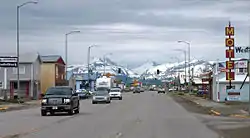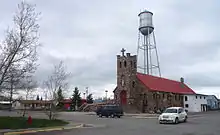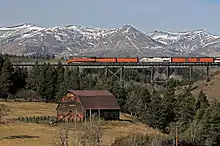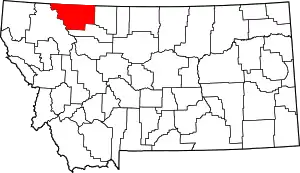Browning, Montana
Browning (originally Browning Indian Agency)[4] is a town in Glacier County, Montana, United States. It is the headquarters for the Blackfeet Indian Reservation and the only incorporated town on the Reservation. The population was 1,016 at the 2010 census.
Browning, Montana | |
|---|---|
| Town of Browning | |
 Downtown Browning in May 2011 | |
 Location of Browning, Montana | |
| Coordinates: 48°33′25″N 113°0′52″W | |
| Country | United States |
| State | Montana |
| County | Glacier |
| Area | |
| • Total | 0.28 sq mi (0.72 km2) |
| • Land | 0.28 sq mi (0.72 km2) |
| • Water | 0.00 sq mi (0.00 km2) |
| Elevation | 4,377 ft (1,334 m) |
| Population | |
| • Total | 1,016 |
| • Estimate (2019)[3] | 1,014 |
| • Density | 3,673.91/sq mi (1,416.73/km2) |
| Time zone | UTC-7 (Mountain (MST)) |
| • Summer (DST) | UTC-6 (MDT) |
| ZIP code | 59417 |
| Area code(s) | 406 |
| FIPS code | 30-10375 |
| GNIS feature ID | 0802063 |
| Website | www.BrowningMontana.com |
The town was named in 1885 for Commissioner of Indian Affairs D. M. Browning.[4] The post office was established in 1895.[5]
Geography
Browning is located at 48°33′25″N 113°0′52″W (48.556917, -113.014571).[6]
According to the United States Census Bureau, the town has a total area of 0.27 square miles (0.70 km2), all land.[7]


Climate
Browning has a warm-summer humid continental climate (Dfb), bordering on a subarctic climate. From January 23, 1916, to January 24, 1916, the temperature fell 100 °F (56 °C) from 44 °F (7 °C) to -56 °F (-49 °C). This is the United States' and also the world record for the greatest temperature drop in 24 hours.[8] Browning's climate is semi-arid and continental. Temperatures above 90 °F (32 °C) occur an average of twice annually, temperatures below 32 °F (0 °C) occur an average of 196 days annually, and those below 0 °F (−18 °C) occur an average of 32 days annually. There is a large degree of diurnal temperature variation that occurs in the summer, but not as much in the winter. Large temperature swings are possible, especially in fall, winter and spring. Arctic air intrusions from western Canada can bring sudden, severe temperature drops, while chinook events, with Pacific-originating warmer air descending from mountain ranges to the west, can result in dramatic temperature rises. Precipitation averages just over 14 inches per year, rendering the climate semi-arid. Precipitation is largely snow from November to March or April. Average monthly precipitation is lowest in winter and highest in the warm season. On average, June is the wettest month, with showers and thunderstorms most likely among all months.
| Climate data for Browning (1894-1989) | |||||||||||||
|---|---|---|---|---|---|---|---|---|---|---|---|---|---|
| Month | Jan | Feb | Mar | Apr | May | Jun | Jul | Aug | Sep | Oct | Nov | Dec | Year |
| Record high °F (°C) | 66 (19) |
68 (20) |
72 (22) |
91 (33) |
93 (34) |
100 (38) |
99 (37) |
102 (39) |
94 (34) |
83 (28) |
72 (22) |
69 (21) |
102 (39) |
| Average high °F (°C) | 28.2 (−2.1) |
31.9 (−0.1) |
38.0 (3.3) |
50.5 (10.3) |
60.7 (15.9) |
68.1 (20.1) |
77.8 (25.4) |
76.0 (24.4) |
65.4 (18.6) |
55.2 (12.9) |
40.2 (4.6) |
32.2 (0.1) |
52.0 (11.1) |
| Average low °F (°C) | 8.0 (−13.3) |
11.2 (−11.6) |
16.9 (−8.4) |
27.3 (−2.6) |
35.5 (1.9) |
41.8 (5.4) |
46.1 (7.8) |
44.4 (6.9) |
37.5 (3.1) |
30.9 (−0.6) |
19.9 (−6.7) |
13.3 (−10.4) |
27.7 (−2.4) |
| Record low °F (°C) | −56 (−49) |
−46 (−43) |
−38 (−39) |
−14 (−26) |
1 (−17) |
21 (−6) |
24 (−4) |
19 (−7) |
0 (−18) |
−17 (−27) |
−39 (−39) |
−47 (−44) |
−56 (−49) |
| Average precipitation inches (mm) | 0.81 (21) |
0.70 (18) |
0.81 (21) |
1.09 (28) |
2.00 (51) |
2.77 (70) |
1.51 (38) |
1.39 (35) |
1.53 (39) |
0.83 (21) |
0.81 (21) |
0.72 (18) |
14.97 (381) |
| Average snowfall inches (cm) | 9.5 (24) |
8.3 (21) |
8.9 (23) |
6.6 (17) |
2.3 (5.8) |
0.4 (1.0) |
0.1 (0.25) |
0.1 (0.25) |
2.6 (6.6) |
4.2 (11) |
7.4 (19) |
9.1 (23) |
59.5 (151.9) |
| Source: [9] | |||||||||||||
Demographics
| Historical population | |||
|---|---|---|---|
| Census | Pop. | %± | |
| 1920 | 986 | — | |
| 1930 | 1,172 | 18.9% | |
| 1940 | 1,825 | 55.7% | |
| 1950 | 1,691 | −7.3% | |
| 1960 | 2,011 | 18.9% | |
| 1970 | 1,700 | −15.5% | |
| 1980 | 1,226 | −27.9% | |
| 1990 | 1,170 | −4.6% | |
| 2000 | 1,065 | −9.0% | |
| 2010 | 1,016 | −4.6% | |
| 2019 (est.) | 1,014 | [3] | −0.2% |
| U.S. Decennial Census[10] | |||
2010 census
As of the census[2] of 2010, there were 1,016 people, 360 households, and 243 families living in the town. The population density was 3,763.0 inhabitants per square mile (1,452.9/km2). There were 394 housing units at an average density of 1,459.3 per square mile (563.4/km2). The racial makeup of the town was 5.5% White, 92.7% Native American, and 1.8% from two or more races. Hispanic or Latino of any race were 3.7% of the population.
There were 360 households, of which 45.3% had children under the age of 18 living with them, 28.6% were married couples living together, 28.6% had a female householder with no husband present, 10.3% had a male householder with no wife present, and 32.5% were non-families. 27.2% of all households were made up of individuals, and 8% had someone living alone who was 65 years of age or older. The average household size was 2.82 and the average family size was 3.43.
The median age in the town was 29.8 years. 33.1% of residents were under the age of 18; 9.6% were between the ages of 18 and 24; 23.6% were from 25 to 44; 23% were from 45 to 64; and 10.7% were 65 years of age or older. The gender makeup of the town was 46.1% male and 53.9% female.
2000 census
| Languages (2000)[11] | Percent |
|---|---|
| Spoke English at home | 90.76% |
| Spoke Blackfoot at home | 9.24% |
As of the census[12] of 2000, there were 1,065 people, 360 households, and 254 families living in the town. The population density was 3,911.2 people per square mile (1,523.0/km2). There were 409 housing units at an average density of 1,502.0 per square mile (584.9/km2). The racial makeup of the town was 6.57% White, 90.52% Native American, 0.09% from other races, African American, 0.09% and 2.72% from two or more races. Hispanic or Latino of any race were 1.88% of the population.
There were 360 households, out of which 39.2% had children under the age of 18 living with them, 36.7% were married couples living together, 25.3% had a female householder with no husband present, and 29.2% were non-families. 27.2% of all households were made up of individuals, and 8.9% had someone living alone who was 65 years of age or older. The average household size was 2.81 and the average family size was 3.40.
In the town, the population was spread out, with 31.5% under the age of 18, 10.3% from 18 to 24, 28.1% from 25 to 44, 18.1% from 45 to 64, and 12.0% who were 65 years of age or older. The median age was 31 years. For every 100 females, there were 83.0 males. For every 100 females age 18 and over, there were 77.2 males.
The median income for a household in the town was $23,879, and the median income for a family was $25,000. Males had a median income of $24,375 versus $20,972 for females. The per capita income for the town was $8,955. About 28.3% of families and 29.2% of the population were below the poverty line, including 33.4% of those under age 18 and 23.6% of those age 65 or over.
Media
Browning is home to low-power radio station KBWG-LP, broadcasting at 107.5 FM.[13]
Transportation
- US Route 2 comes into Browning from East Glacier from the west.
- US Route 89 comes into Browning from St. Mary from the north.
- The two US Routes meet on the western end of Browning and run through town together, splitting on the eastern end of town, with US 2 headed east towards Cut Bank and Shelby and US 89 headed south towards Choteau and Great Falls.
- US Route 87 ran through Browning until 1934, when US 89 replaced its original routing north of Great Falls. US 87 then ended in Great Falls until 1945, when it was changed to run from Great Falls to Havre.[14]
- Amtrak's Chicago to Portland/Seattle Empire Builder serves Browning from October to April at a station just south of town. East Glacier receives passengers just a few miles west, from April to October.
Education
Browning is home to Blackfeet Community College.
Notable people
- Billy Wagner, professional boxer
- Elouise Pepion Cobell, MacArthur genius award winner, a tribal elder and activist, banker (The Native American Bank), rancher, and lead plaintiff in the groundbreaking class-action suit Cobell v. Salazar (2009). Cobell was awarded the Presidential Medal of Freedom, the highest civilian award of the United States.
- Joe Hipp, professional boxer, was born here.
- Denise Juneau (Mandan, Hidatsa, and Arikara Nation), politician, Superintendent of Public Instruction and first Native American woman elected to statewide office in Montana; 2016 candidate for Congress; went to high school here
- Steve Reevis (Blackfoot), actor, was born here, growing up on the Blackfeet Reservation. His films include Dances with Wolves, Geronimo: An American Legend, Fargo, and The Missing.
- Hart Merriam Schultz, American Indian artist born outside of town on the Blackfeet Reservation.
- Robert Scriver, sculptor, operated a museum in Browning.
- James Welch, Native American poet and author, was born here.
In popular culture
Browning is the setting for the TV-series The X-Files episode "Shapes".
Images
 Post office
Post office Former Intersection of U.S. Route 2 and U.S. Route 89 in Browning; this intersection is now a roundabout.
Former Intersection of U.S. Route 2 and U.S. Route 89 in Browning; this intersection is now a roundabout. Blackfeet Community Hospital
Blackfeet Community Hospital
References
- "2019 U.S. Gazetteer Files". United States Census Bureau. Retrieved July 26, 2020.
- "U.S. Census website". United States Census Bureau. Retrieved 2012-12-18.
- "Population and Housing Unit Estimates". United States Census Bureau. May 24, 2020. Retrieved May 27, 2020.
- "Montana Place Names Companion". Montana Historical Society. Retrieved 29 July 2017.
- Carkeek Cheney, Roberta (1983). Names on the Face of Montana. Missoula, Montana: Mountain Press Publishing Company. ISBN 0-87842-150-5.
- "US Gazetteer files: 2010, 2000, and 1990". United States Census Bureau. 2011-02-12. Retrieved 2011-04-23.
- "US Gazetteer files 2010". United States Census Bureau. Archived from the original on 2012-07-02. Retrieved 2012-12-18.
- "Top Ten Montana Weather Events of the 20th Century". National Weather Service Unveils Montana's Top Ten Weather/Water/Climate Events of the 20th Century. National Weather Service. Retrieved 2015-06-01.
- "BROWNING, MONTANA (241202)". Western Regional Climate Center. Retrieved May 30, 2016.
- "Census of Population and Housing". Census.gov. Retrieved June 4, 2015.
- "Data Center Results".
- "U.S. Census website". United States Census Bureau. Retrieved 2008-01-31.
- "FM Query Results -- Audio Division (FCC) USA". Federal Communications Commission. Retrieved August 22, 2012.
- "End of US Highway 87". US ENDS. Retrieved 30 June 2018.
